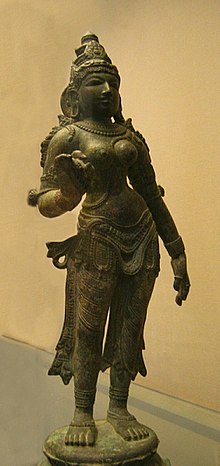17th SEPTEMBER 2015 BHUMI DEVI - EARTH GODDESS
Bhūmi
From Wikipedia, the free encyclopedia
| Bhumi | |
|---|---|
| Earth | |

Metal Sculpture of Goddess Bhudevi
| |
| Affiliation | Devi |
| Consort | Varaha (Vishnu) |
Bhūmi (Sanskrit: भूमि), also Bhūmī-Devī (Sanskrit: भूमी देवी), Bhuma-Devi or Bhū-Devī, is the personification of Mother Earth. She is the consort of Varaha, an avatar of Vishnu and regarded as the mother of the goddess Sita. According to the uttara-kanda, when Sita finally leaves her husband Rama, she returns to Bhumidevi. She is the mother of the demon Narakasura .[1] Bhumi Devi is also believed to be one of the two forms of Lakshmi. The other is Sridevi, who remains with Narayana. Bhudevi is the Goddess of Earth, and the fertility form of Lakshmi. She is the daughter of Kashyap Prajapati. According to some she is also Satyabhama, wife of Sri Krishna in Dwapara Yuga and the divine saint Andal. Several female deities have had births similar to Sita. Alamelu Mangamma or Sri Padmavathi Devi of Tiruchanur had a similar beginning, being found in a ploughed field by Akasa Raja. Andal from Srivilliputtur in Tamil Nadu was found under a Tulasi plant by Periyaalvar.[citation needed]
Bhudevi incarnates Herself as Andaal[edit]
Bhu devi incarnates Herself in South india in a place named sriviliputhur as Andaal (Tamil: ஆண்டாள் Äṇɖāḷ is the only female Alvar among the 12 Alvar saints of South India. The Alvar saints are known for their affiliation to the Srivaishnava tradition of Hinduism. Born in 10th Century CE,[1][2] she is credited with the great Tamil works, Thiruppavai and Nachiar Tirumozhi, that are still recited by devotees during the winter festival season of Margazhi. she is known for her unwavering devotion to Lord Vishnu, the God of the Srivaishnavas. She was adopted by the Alvar saint, Periyalvar, who found her as a baby lying under a tulasi (Ocimum tenuiflorum) plant in the temple garden of Srivilliputhur. she is often referred to as "Kodhai" or "Goda"
Iconography[edit]
She is depicted in votive statuary, seated on a square platform which rests on the back of four elephants representing the four directions of the world. When depicted with four arms, she holds a pomegranate, a water vessel, a bowl containing healing herbs, and another containing vegetables.[2] When shown with two arms, she holds a blue lotus known as Kumuda or Utpala the night lotus, in the right hand.[3] The left hand may be in the Abhaya Mudra - fearlessness or the Lolahasta Mudra which is an aesthetic pose meant to mimic the tail of a cow.[4]
Festivals[edit]
- Tirumala festivals
- Raja Parva



No comments:
Post a Comment